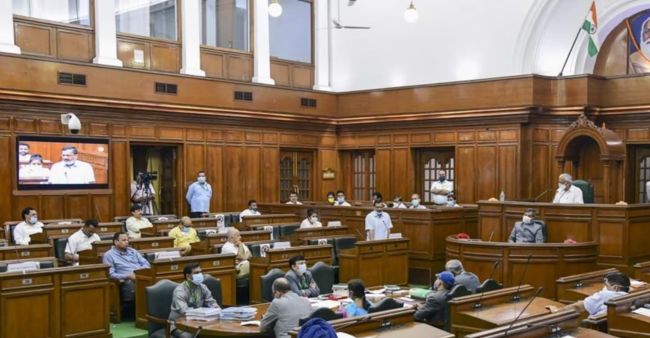peculation on whether there was any further need to have an Assembly for Delhi has commenced following the passage of the Services Bill, which has enhanced the powers of the Lt Governor at the expense of the elected government.
Although the Aam Aadmi Party (AAP), which is in power in the national capital, is confident that the new legislation would be struck down by the Apex Court, yet there are many who are wondering on the purpose being served by an Assembly which has no powers.
The Delhi Assembly was always a debating chamber rather than a House with any gravitas, and after the Centre has clipped the wings of the Chief Minister and his Cabinet, there seems to be very little logic in continuing with the arrangement.
Many had expected that Chief Minister Arvind Kejriwal would resign after the Centre divested him of all his powers, but it is evident that the AAP boss is not going to surrender without a fight, which he believes would furnish him with political dividends.
Those who favour the Assembly to be scrapped, are of the view that it serves no purpose. The MLAs are paid hefty salaries for doing no work and the House meets for a few hours, and has hardly any business on its agenda. In fact, when in the Assembly on Thursday, Kejriwal launched an attack on the Prime Minister, the BJP members were quick to point out that he was going beyond his jurisdiction in using the floor of the House for political objectives.
AAP’s supporters were swift to point out that the BJP could be accused of using Parliament to further its political agenda and it had no right in attacking the Delhi Chief Minister, who was singularly drawing attention to the failure of the Prime Minister to visit Manipur, despite the huge crisis that had been deliberately created.
The Delhi Assembly with truncated powers came into being in 1993 following the recommendations of the Sarkaria-Balakrishnan Committee that was constituted to end the multiplicity of authority in the national capital. However, what the committee eventually did was to not only retain the multiplicity of authority and instead of empowering the elected representatives, conferred more powers on the bureaucracy, both in the Assembly and the Delhi Municipal Corporation.
The reason why the experiment succeeded initially was because the first Delhi Chief Minister, Madan Lal Khurana was a mass leader, whose voice and authority was respected by the bureaucracy. The template of governance was set and even after Khurana resigned to express solidarity with Lal Krishna Advani, whose name figured in the Jain diaries connected with the Hawala scandal, the Chief Minister’s position, both during Sahib Singh Verma and Sushma Swaraj’s tenures remained unaffected.
There were other reasons as well. Khurana was allowed to have his way because Prime Minister P.V. Narasimha Rao did not see eye to eye with the then Delhi Congress leadership led by H.K.L. Bhagat. After Rao, both H.D. Deve Gowda and Inder Kumar Gujaral were engrossed with their own survival, and did not bother about who was administering Delhi. When Atal Behari Vajpayee returned in 1998, he decided to bring back Khurana, but ended up installing Sushma Swaraj as the Chief Minister to replace Sahib Singh due to internal party manipulations by his colleague, Pramod Mahajan.
In 1998 December, the Congress, which was energised after Sonia Gandhi took over the reins, trounced the BJP in the Assembly polls, and Sheila Dikshit was appointed the Chief Minister, courtesy the backing she received from Makhan Lal Fotedar and other powerful friends, who convinced the new party president.
Sheila remained in power for 15 years, and while Vajpayee was the Prime Minister and the NDA controlled the Central government, she shared a close personal bond with top BJP leaders, who considered her to be convenient since they were unable to sort out differences between Khurana and Sahib Singh, who were constantly clashing. Being the wife of a bureaucrat, Sheila also got along fabulously with the bureaucracy since she empowered the officials at the cost of politicians.
Many political observers were also of the opinion that the BJP had a soft corner for Sheila and therefore always put up a relatively weak candidate against her from the Gole Market constituency (later New Delhi) to enable her to win. Therefore, when Kejriwal finally decided to contest against her in 2013, she was routed in the polls and the Congress lost power. Kejriwal’s relationship with the Centre has always been turbulent and he has preferred a confrontationist approach instead of carrying everyone along with him. Thus, it is not surprising that the BJP decided to hit back by taking away a sizable extent of his powers. Law and order and land use were always with the Centre, which now also has the right to transfer officials.
In the unfolding political scenario, the Delhi Assembly has lost its relevance. It can do nothing if the officials it summons, do not show up. There are many who believe that the city has 10 MPs including seven in the Lok Sabha and more than 270 members in the municipal corporation, who are there to address local issues.
Therefore, was it feasible politically and financially to continue with the Assembly? It would have made more sense if Delhi was granted full statehood as had been demanded by the BJP since its inception. An Assembly with no political muscles can be construed as demeaning to the people. Between us.

